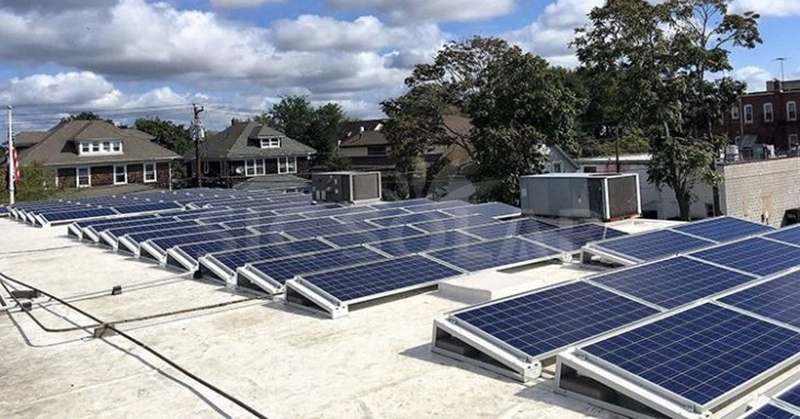Flat roofs are increasingly favored for solar panel installations due to their open and unobstructed surface. However, selecting the right solar roofing system is crucial to ensure durability, efficiency, and ease of installation. Each roofing system offers unique benefits, and the choice largely depends on the roof’s material, structure, and location-specific requirements.

Key Considerations for Flat Roof Solar Systems
Flat roofs present distinct advantages for solar installations, including ease of access and the ability to optimize the tilt angle of solar panels. However, they also pose unique challenges.
- Load Management: Solar panels, mounting systems, and environmental loads like snow or wind must be supported without compromising the roof’s integrity.
- Water Drainage: Flat roofs can accumulate water, so the mounting system should facilitate proper drainage to avoid pooling.
- Non-Invasive Installation: Many flat roofs benefit from ballasted systems that don’t require penetrations, preserving the roof’s waterproofing layer.
Top Solar Roofing Systems for Flat Roofs
- Ballasted Mounting Systems
- Overview: Ballasted systems rely on weights to secure solar panels in place without penetrating the roof.
- Benefits:
- Non-invasive, preserving the roof’s structure
- Easy to install and adjust
- Ideal for roofs with limited structural strength
- SIC Solar Contribution: SIC Solar offers high-quality ballasted mounting systems designed for optimal stability and efficiency. Their corrosion-resistant materials ensure durability even in harsh weather.
- Adhesive Mounting Systems
- Overview: Adhesive systems use strong industrial adhesives to secure mounts directly to the roof’s surface.
- Benefits:
- Lightweight and easy to install
- No need for drilling or additional ballast
- Applications: Best suited for lightweight solar arrays in areas with low wind speeds.
- Metal-Framed Mounting Systems
- Overview: These systems use metal frames to support panels, often anchored through minimal penetrations or adhesives.
- Benefits:
- Durable and versatile for different panel configurations
- Adjustable tilt angles to maximize sunlight exposure
- SIC Solar Contribution: SIC Solar provides pre-assembled metal-framed systems, ensuring quick and reliable installations.
- Green Roof and Solar Hybrid Systems
- Overview: Green roofs, which include vegetation, can be integrated with solar arrays. Mounting systems are elevated to allow for plant growth beneath the panels.
- Benefits:
- Improves insulation and reduces urban heat islands
- Enhances building sustainability
- Challenges: Requires careful planning to balance weight and drainage.
- Tilted Solar Racking Systems
- Overview: These systems elevate and tilt solar panels to the optimal angle for maximum sunlight exposure.
- Benefits:
- Boosts energy production compared to flat installations
- Suitable for all flat roof types
- SIC Solar Contribution: SIC Solar designs modular tilted racking systems that adapt to various flat roof surfaces, ensuring peak performance.
Why SIC Solar for Flat Roof Solar Mounting?
SIC Solar specializes in innovative and reliable solar mounting solutions tailored to flat roofs. Their systems are designed with:
- Durability: Constructed from high-quality materials to withstand extreme weather conditions.
- Flexibility: Compatible with various roof types, including concrete, PVC membranes, and green roofs.
- Ease of Installation: Pre-assembled parts reduce labor time and cost.
- Sustainability: Their mounting systems are optimized to complement eco-friendly roofing designs.
With SIC Solar, clients benefit from a seamless transition to solar energy while preserving their flat roof’s integrity and functionality.
Selecting the Best System for Your Flat Roof
When choosing the right solar roofing system, consider the following:
- Structural Capacity: Assess the roof’s ability to support additional weight. Ballasted or adhesive systems are ideal for lightweight structures.
- Weather Conditions: In high-wind or snow-prone areas, reinforced mounting systems provide added stability.
- Roof Material: The roofing material determines whether penetrative, adhesive, or ballasted systems are most appropriate.
- Energy Goals: Tilted systems are optimal for maximizing energy output, while flat configurations may suffice for lower demands.
The best solar roofing system for flat roofs depends on the specific needs of the building and its environment. From ballasted systems to tilted racking, modern mounting solutions make flat roofs an excellent platform for solar energy production.
Companies like SIC Solar are leading the way with advanced mounting technologies, ensuring reliable, durable, and efficient solar installations. Whether for residential, commercial, or industrial projects, their solutions help maximize the potential of solar energy while maintaining the integrity of flat roofs.
Invest in the right system today and take a step toward sustainable energy!